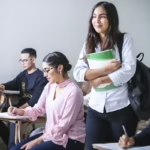When the Ohio school board suspends high school programs the repercussions go far beyond academics. The decision to halt grades nine through twelve at Beallsville High School marked the end of a historic institution that shaped not just students, but an entire community. For many, a school is not simply a building—it is the heartbeat of local life, where milestones are celebrated, friendships formed and traditions upheld. The closure has left families grappling with both uncertainty and grief.
What makes this decision especially important is that it is not isolated. Rural communities across the country face similar struggles, where declining enrollment and financial challenges collide with the deep emotional ties residents hold to their schools. By examining the details of Beallsville’s story, one gains insight into the broader challenges facing education in rural America, as well as the resilience of families who must adapt to sudden, life-changing transitions.
Background of the School Board’s Decision
The Switzerland of Ohio Local School Board voted unanimously to suspend Beallsville High School’s grades nine through twelve. Declining enrollment numbers were the central reason, but the process by which the decision was made stirred controversy. The board moved swiftly, entering executive session immediately after the vote, leaving families with unanswered questions. For parents and students, the lack of open dialogue felt like a betrayal of trust.
This situation reflects a difficult truth: school boards often must choose between financial sustainability and community heritage. Yet how those decisions are communicated can either strengthen or weaken public trust. In Beallsville, the abruptness created a sense of exclusion. Had the board provided more opportunities for discussion, families may not have agreed with the outcome, but they may have accepted it with greater understanding. Instead, many were left with frustration, fueling broader debates about how communities should be included in education policy.
Timeline of Events Leading to Suspension
| Date / Stage | Action Taken by Board | Community Awareness | Reaction from Families |
| Early 2023 | Decline in enrollment noted | Minimal | Concern from a few parents |
| Summer 2023 | Private board discussions | Limited | Little public awareness |
| Winter 2023 | Closure considered seriously | Rumors circulated | Anxiety grew among families |
| Spring 2024 | 5-0 vote announced | Widespread shock | Anger, sadness, frustration |
Why Enrollment Numbers Matter in Small Districts
In small districts, every student matters. Funding is tied directly to enrollment, and when numbers fall, the entire system feels the strain. At Beallsville, fewer students meant shrinking state aid, reduced course offerings, and challenges in maintaining extracurricular programs. Even essential services like transportation and building upkeep became disproportionately costly compared to the small student body.
This pattern is part of a larger cycle. Families sometimes leave small towns for economic opportunities elsewhere, leading to population decline. As schools lose students, the academic experience narrows, discouraging families from staying, and further fueling the decline. When enrollment dips too low, maintaining a high school becomes financially unsustainable. The suspension of Beallsville’s high school program was therefore not just about numbers, but about systemic challenges facing rural education.
Enrollment Levels and Effects on Small District Schools
| Student Population | Academic Programs Available | Extracurricular Options | Financial Stability |
| 500+ students | Full range, AP and electives | Robust sports, clubs | Stable |
| 300–499 students | Limited AP, core electives | Fewer teams and groups | Moderate strain |
| 150–299 students | Basic offerings only | Minimal opportunities | High pressure |
| <150 students | Core curriculum only | Few or merged programs | Unsustainable |
The Impact on Beallsville High School Students
For students, the closure was more than an administrative decision—it was a disruption to their daily lives and future plans. High school years are formative, filled with milestones like prom, senior night, and graduation. The loss of these traditions left many students feeling deprived of closure. For juniors and seniors, in particular, finishing their education at a different school meant adjusting academically and emotionally at a critical time.
Reassignments split the student body, with some attending River High School and others moving to Monroe Central. This division forced friendships to stretch across new boundaries, creating additional stress. While education continues, the social fabric that makes high school meaningful has been torn. Students must now build new peer groups, adjust to new teachers, and adapt to unfamiliar environments. These changes highlight how closures are not just financial matters but deeply personal events that reshape young lives.
Parent and Community Reactions
Parents voiced frustration at the lack of input. Many believed the decision was rushed, leaving them without an opportunity to propose alternatives or prepare for the transition. Concerns also centered on logistics—longer bus rides, larger classroom sizes, and the potential for students to feel lost in bigger schools. For parents who valued the small, supportive environment of Beallsville High, the shift felt overwhelming.
Community members expressed sadness over the loss of a shared tradition. High school sports, concerts, and ceremonies once brought the entire town together. Without these events, residents feared a decline in civic pride. For small towns, schools often act as social glue, and the closure raised concerns about whether Beallsville could maintain its identity without a high school at its center. The reaction was not just emotional but also practical, as families worried about the ripple effects on property values and local engagement.
Community Concerns Following Suspension
| Concern | Parent Perspective | Community Impact |
| Lack of public input | “We deserved a say in this process.” | Declining trust in leadership |
| Transportation issues | Longer bus rides for younger students | Strain on daily routines |
| Cultural identity loss | Loss of traditions like pep rallies | Decline in community pride |
| Economic concerns | Fear of reduced property values | Possible relocations |
Emotional Significance of Small-Town Schools
Small-town schools hold symbolic value that extends far beyond academics. They are places where children grow up under the watchful eyes of their neighbors, and where community identity is reinforced through shared traditions. From Friday night football games to school plays, these events serve as vital gathering points for residents of all ages. When such a school closes, it creates a void that is difficult to replace.
For Beallsville, the high school was more than a building; it was a cultural anchor. Without it, alumni lose a connection to their roots, and younger students lose the sense of pride that comes from representing their hometown. Sociologists argue that the closure of rural schools often results in weakened civic participation, reduced community cohesion, and even population decline as families relocate. In Beallsville, these emotional consequences are as profound as the logistical challenges of reassigning students.
Alternative Schools and Student Reassignments
The suspension of Beallsville’s high school program left families with reassignment plans. Students east of Beallsville were directed to River High School, while those west were sent to Monroe Central. To ease the transition, the district also extended open enrollment, allowing parents to choose different options if desired. While the plan ensured educational continuity, it raised logistical and social challenges.
Transportation had to be restructured, with bus routes extended to accommodate longer commutes. Administrators at River and Monroe Central had to prepare for an influx of students, both academically and socially. Integrating new students requires intentional efforts, from orientation programs to counseling support. Without these measures, students risk feeling isolated in their new environments. A well-structured reassignment plan can soften the impact, but it cannot replace the sense of identity lost when a local school closes.
Student Reassignment Details
| Location of Residence | New School Assigned | Approximate Travel Time | Key Adjustments Required |
| East of Beallsville | River High School | 25–40 minutes | Orientation, new academic pacing |
| West of Beallsville | Monroe Central | 20–35 minutes | Peer integration, sports eligibility |
| Open enrollment option | Parent choice | Varies | Application and acceptance process |
Academic Challenges During Transition
Adapting to new schools brings significant academic hurdles. Curriculum differences may result in students losing access to certain electives or advanced placement opportunities. For some, this could impact college readiness or disrupt carefully planned academic paths. Teachers must also work to integrate new students smoothly, ensuring that their previous coursework aligns with new grading systems and standards.
Research on rural school consolidations shows that academic performance often dips during the first year of transition. Students may struggle with motivation due to stress and uncertainty, while parents worry about long-term impacts on learning outcomes. To counter these challenges, schools must provide consistent support through counseling, tutoring, and careful credit evaluation. While some students may eventually thrive in larger settings, the initial adjustment period requires attention and compassion from administrators, teachers, and families alike.
9. Social and Athletic Impacts of Reassignment
Extracurricular activities are often the heart of student life, and Beallsville High’s closure disrupted cherished traditions. Athletics held particular importance, with local rivalries uniting not only students but the broader community. Reassignment forced students into established teams at River and Monroe Central, where competition for positions already existed. This created challenges both for incoming students seeking acceptance and for existing teams adjusting to new dynamics.
Socially, the closure fractured established peer groups. Friendships formed over years of shared classrooms were divided across two different schools. For teenagers, who rely heavily on social connections for stability, these changes were particularly difficult. Beyond students, the community also felt the loss of Friday night games and school plays that once brought everyone together. While opportunities remain at larger schools, the unique identity and intimacy of Beallsville’s extracurricular programs can never be replicated in exactly the same way.
Comparison of Extracurricular Opportunities
| Activity Type | Beallsville (Before) | River / Monroe Central (After) | Change for Students |
| Athletics | Football, basketball, cheer | Expanded sports programs | More options, harder competition |
| Music / Arts | Small choir, band, drama club | Larger choirs, full band, theater | Greater variety, less personal |
| Clubs & Academics | Limited academic clubs | Debate, robotics, STEM programs | New exposure, adjustment needed |
Broader Trends in Rural School Consolidations
Beallsville’s closure is not an isolated event but part of a broader national trend. Rural America has seen population decline due to economic shifts, industry changes, and migration toward urban centers. With fewer families, schools struggle to maintain enrollment levels necessary for financial sustainability. Consolidations, while painful, have become a strategy for survival.
Advocates argue that consolidations allow for stronger academic programs, improved facilities, and more extracurricular opportunities. Critics, however, highlight the cost in terms of community identity and student well-being. While larger schools may offer more resources, they cannot replicate the intimacy of smaller environments. Beallsville’s story mirrors that of many rural towns, serving as a reminder that education policy must balance financial realities with the cultural importance of schools in shaping local identity.
How School Boards Make Closure Decisions
School boards face difficult responsibilities, balancing budgets with educational needs. When the Ohio school board suspends high school programs, the process typically involves analyzing demographic trends, funding formulas, and long-term projections. Board members must weigh costs of staffing, transportation, and building maintenance against available funding.
However, the way these decisions are carried out matters just as much as the decision itself. Public engagement, transparency, and community trust are essential for legitimacy. Boards that communicate openly and provide opportunities for public input often face less backlash, even when outcomes are unpopular Ohio School Board Suspends High School. In Beallsville, the lack of dialogue amplified resentment, underscoring the importance of involving communities in discussions about closures. When boards blend financial responsibility with respectful engagement, they help families navigate difficult transitions with greater resilience.
Typical Steps in School Closure Decisions
| Step in Process | Purpose | Potential Pitfall |
| Enrollment review | Identify declining numbers | Data without context |
| Financial analysis | Determine cost sustainability | Ignoring community impacts |
| Public consultation | Allow feedback and ideas | Skipping or minimizing dialogue |
| Board vote | Finalize decision | Perceived as abrupt or opaque |
Lessons for Other Communities Facing Similar Situations
Beallsville’s experience offers important lessons. First, communication is critical. Parents and students want transparency and opportunities to voice concerns before decisions are finalized. Second, transition planning must go beyond logistics to address emotional and social impacts. Support services like counseling, orientation, and peer mentoring ease the adjustment process.
Another lesson is the importance of preserving traditions. Even when schools close, communities can find ways to honor their history. Incorporating mascots, colors, or annual events into new schools helps keep legacies alive. Finally, proactive planning is essential Ohio School Board Suspends High School. Rural communities experiencing population decline should begin exploring options early, rather than waiting until closure becomes unavoidable. These lessons can help other districts navigate challenges with greater foresight, compassion, and respect for the cultural significance of schools.
Lessons Learned for Future Rural Education Planning
| Key Lesson | Explanation | Benefit for Communities |
| Transparency | Open dialogue builds trust | Reduces backlash and resentment |
| Transition support | Academic and emotional resources matter | Smooth adjustment for students |
| Preserving traditions | Retain mascots, events, cultural ties | Maintains community identity |
| Early planning | Anticipate enrollment and funding trends | Prevents abrupt decisions |
Conclusion and Future Outlook
The Ohio school board suspends high school decision at Beallsville represents both financial necessity and cultural loss. Declining enrollment made continuation unsustainable, yet the emotional cost for students, parents, and community members was profound Ohio School Board Suspends High School. While students now have new opportunities at River and Monroe Central, the legacy of Beallsville High will always remain in the hearts of its alumni and residents.
Looking forward, the closure serves as a reminder that rural education policy must balance fiscal responsibility with the preservation of cultural identity. Communities must adapt, but they also must be given a voice. The future of rural schools will depend not only on numbers but on how districts engage families in shaping educational landscapes. Beallsville’s story is one of both loss and resilience, offering lessons for other communities facing similar crossroads.
FAQs
1. Why did the Ohio school board suspend Beallsville High School?
The primary reason was declining enrollment, which reduced state funding and made it financially unsustainable to operate a full high school program.
2. Where will Beallsville students go after the closure?
Students east of Beallsville were reassigned to River High School, while those west were directed to Monroe Central. Families also have open enrollment options in other districts.
3. How does school closure affect students academically?
Closures often cause temporary academic disruption as students adjust to new curricula, grading systems, and classroom environments. With proper support, performance stabilizes over time.
4. What emotional impacts do closures have on communities?
Closures result in sadness, frustration, and loss of community pride. Schools often serve as cultural hubs, so their absence weakens civic engagement and traditions.
5. What can other districts learn from Beallsville’s experience?
The importance of transparency, early planning, and support for students cannot be overstated. Communities facing similar challenges should prioritize open dialogue and creative solutions to preserve identity.







